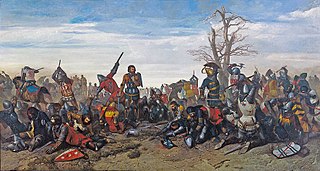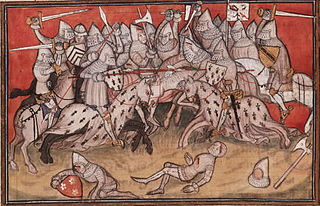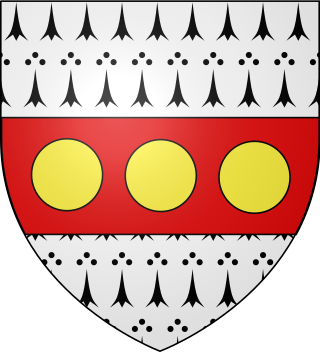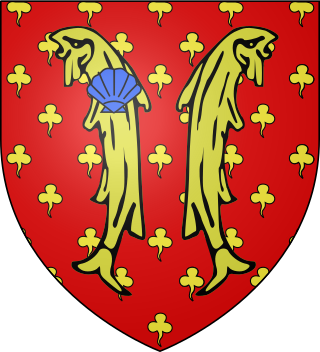
The Combat of the Thirty, occurring on 26 March 1351, was an episode in the Breton War of Succession fought to determine who would rule the Duchy of Brittany. It was an arranged fight between selected combatants from both sides of the conflict, fought at a site midway between the Breton castles of Josselin and Ploërmel among 30 champions, knights, and squires on each side. The challenge was issued by Jean de Beaumanoir, a captain of Charles of Blois supported by King Philip VI of France, to Robert Bemborough, a captain of Jean de Montfort supported by Edward III of England.

The War of the Breton Succession was a conflict between the Counts of Blois and the Montforts of Brittany for control of the Sovereign Duchy of Brittany, then a fief of the Kingdom of France. It was fought between 1341 and 12 April 1365. It is also known as the War of the Two Jeannes due to the involvement of two rival duchesses of that name.

Bertrand du Guesclin, nicknamed "The Eagle of Brittany" or "The Black Dog of Brocéliande", was a Breton knight and an important military commander on the French side during the Hundred Years' War. From 1370 to his death, he was Constable of France for King Charles V. Well known for his Fabian strategy, he took part in seven pitched battles and won the five in which he held command.

Ploërmel is a commune in the Morbihan department in Brittany, in north-western France. On 1 January 2019, the former commune Monterrein was merged into Ploërmel.

Louis II of Châtillon, son of Guy I, Count of Blois and Margaret of Valois, was count of Blois and lord of Avesnes from 1342 to 1346.
The Battle of Saint-Pol-de-Léon was a minor action during the Breton War of Succession and thus part of the larger Hundred Years War. The battle was fought in June 1346 and marked a minor turning point in the fortunes of the Montfortists and their English allies in Brittany following several setbacks including the imprisonment and subsequent death of their leader, John of Montfort.

The Battle of Morlaix was fought in Morlaix on 30 September 1342 between the Anglo-Breton and Franco-Breton forces in Brittany. The Anglo-Breton under English command besieged the town, but a Franco-Breton relief force arrived. The English constructed a strong defensive position. After repeated attacks, the French forced the English to retreat into the woods, and the French force then withdrew.

Jean, or Jehan de Beaumanoir, marshal of Brittany for Charles of Blois, and captain of Josselin, is remembered for his share in the famous Combat of the Thirty during the War of Breton Succession (1341–1364) between the warring parties of competing claimants for the Dukedom.

Sir Thomas Dagworth was an English knight and soldier, who led the joint English-Breton armies in Brittany during the Hundred Years' War.
Events from the 1350s in England.

Mauron is a commune in the Morbihan department and Brittany region of north-western France. It lies close to the borders of both Côtes d'Armor and Ille-et-Vilaine. Mauron's location make it a crossroads on the routes connecting Dinan to Vannes and Quimper to Rennes.

Guy II de Nesle, Lord of Mello, was a Marshal of France (1348) who was killed in the Battle of Mauron.

Sir Robert Bemborough (d.1351) was a medieval knight who led the Montfortist faction during the Combat of the Thirty. This was an arranged battle between thirty knights from both sides during the Breton War of Succession, a struggle for control of the duchy between the House of Montfort and the House of Blois. Bemborough was killed in the battle.

The Battle of Calais took place in 1350 when an English force defeated an unsuspecting French army which was attempting to take the city. Despite a truce being in effect the French commander Geoffrey de Charny had planned to take the city by subterfuge, and bribed Amerigo of Pavia, an Italian officer of the city garrison, to open a gate for them. The English king, Edward III, became aware of the plot and personally led his household knights and the Calais garrison in a surprise counter-attack. The French were routed by this smaller force, with significant losses and all their leaders captured or killed.
Amery of Pavy or of Pavia was a 14th-century English knight, originally from Pavia in Lombardy, who was made captain of Calais by King Edward III of England in 1347. He made a secret deal with Sir Geoffrey de Charny, a French knight, to sell Calais for 20,000 écus. After discovering the plot, Edward summoned Amery to London and confronted him, ordering him to keep his bargain with Geoffrey and say nothing of the king's knowledge. As Geoffrey gathered an army to take control of the town in December of that year, Edward brought an army from England to counter the French. The English then prevailed in the failed siege of Calais on 31 December 1349, and Edward transferred governance of Calais to John de Beauchamp and abated the arms of Amery in 1350. In 1352, Amery was captured and tortured to death by Charny.

Jeanne de Clisson (1300–1359), also known as Jeanne de Belleville and the Lioness of Brittany, was a French / Breton former noblewoman who became a privateer to avenge her husband after he was executed for treason by the French King Philip VI. She crossed the English Channel targeting French ships and often slaughtering their crew. It was her practice to leave at least one sailor alive to carry her message of vengeance.
Following the defeat of Mauron during the Breton War of Succession, the Franco-Bretons, led by Bertrand Du Guesclin, took their revenge at the Battle of Montmuran on April 10, 1354.

Sir Walter Bentley was an English knight who fought during the Hundred Year's War.
The siege of Guînes took place from May to July 1352 when a French army under Geoffrey de Charny unsuccessfully attempted to recapture the French castle at Guînes which had been seized by the English the previous January. The siege was part of the Hundred Years' War and took place during the uneasy and ill-kept truce of Calais.
The Treaty of Guînes was a draft settlement to end the Hundred Years' War, negotiated between England and France and signed at Guînes on 6 April 1354. The war had broken out in 1337 and was further aggravated in 1340 when the English king, Edward III, claimed the French throne. The war went badly for France: the French army was heavily defeated at the Battle of Crécy, and the French town of Calais was besieged and captured. With both sides exhausted, a truce was agreed that, despite being only fitfully observed, was repeatedly renewed.













